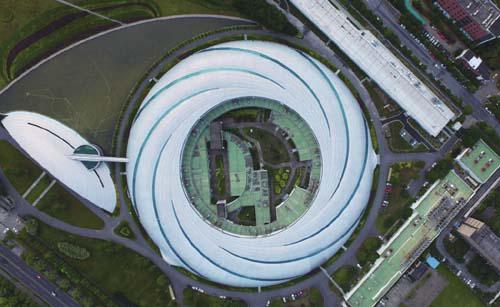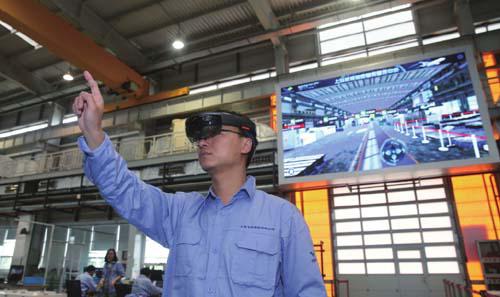SMART AND SHARP
2018-10-23ByYuanYuan
By Yuan Yuan
Su Weiguo, CEO of Hutchison MediPharma, an innovative biopharmaceutical company based in the Pudong New Area in Shanghai, has been under the spotlight lately. Fruquintinib, Chinas first fully domestically-made targeted anti-cancer drug is going to market soon and his company is the developer.
Pharma Valley
Hutchison MediPharma is located in Shanghais Zhangjiang Innopark, which was established in July 1992, two years after the State Council decided to develop Pudong as a new area. Since then, it has identified the biomedical industry as one of the key science and technology industries for development. In August 1996, the National Shanghai Biomedical Science and Technology Industry Base was established, and after more than 20 years of development, it has become the leading biomedical research and development(R&D;) center in China, known as Chinas Pharma Valley.
Set up in the valley in 2002, the company is one of the oldest pharmaceutical companies there. Su joined the firm in 2005 after developing drugs for Pfizer, one of the worlds leading pharmaceutical companies, for 15 years. In Sus opinion, all of the entrepreneurs in Pharma Valley with there with high ambitions; their targets are the hard nuts to crack in the industry: anticancer drugs, new cardiovascular and brain drugs, and related medical devices.
“The incidences of liver cancer, gastric cancer and lung cancer in China are rela-tively high, yet low in other countries, so even if many foreign specialists are very interested in R&D; on relative drugs, it is difficult for them, since they dont get enough patients,” Su said. “So there have been very few drugs targeted for these diseases and the price is normally too high for ordinary Chinese people to afford. This has led to many Chinese scientists living overseas coming back to China in order to work in the field.”
Li Ning, who joined TopAlliance Biosciences Inc. earlier this year, is one such scientist. He was vice president at Sanofi, a Paris-based multinational pharmaceutical company, before joining the company. “TopAlliance is devoted to working on developing drugs based on the conditions of Chinese patients,” Li said.“The drugs need to not only have good curative effects, but be affordable.”
It was the atmosphere of R&D; as well as the complete industrial chain formed in Zhangjiang that attracted Li to settle down in the valley. It was also this perfect industrial cluster that made the companys founder Chen Bo start up his business there in 2012. Chen came to Zhangjiang from Silicon Valley in the United States with only a backpack.
“For drug R&D;, a large amount of money is spent on purchasing equipment and setting up laboratories and production lines, but in Zhangjiang, such costs can be saved as all these money-burning facilities have been well prepared and startup entrepreneurs can use them at a very low price or even for free,” Li said.
In 2015, TopAlliance developed a new anti-cancer drug less than three years after it was established, an unimaginable speed in the industry, as it usually takes more than 10 years to develop such a drug. Now on average, of every three new drugs developed in China, one is created in Pharma Valley.
In Sus view, in addition to having a sound industrial cluster, Pharma Valley has attached great importance to listening to the opinions of enterprises and actively exploring and promoting the formulation and revision of relevant policies. In 2016, Shanghai set up pilot zones with Marketing Authorization Holders (MAH), with the first areas in the country that relaxed restrictions on R&D; pharmaceutical companies. Fruquintinib is one of the first batch of drugs developed after the MAH was established.
Hi-tech incubator
To date, Zhangjiangs Pharma Valley has built hundreds of public platforms and incubated more than 400 biomedical companies. The complete cluster has become the soft power of hi-tech industries in Zhangjiang. With the opening and development of the Pudong New Area, many giant companies, including Honeywell and Momentum, set up their Chinese headquarters in the area. At the same time, many small and micro startups chose to plant their roots in Pudong.
In 2016, the Zhangjiang Multinational Enterprises Joint Incubation Platform was established. This was the first innovation incubator in the country jointly established by multinational corporations. The platforms role is to connect the resources of entrepreneurs, multinational corporations and local outstanding enterprises.
“The multinational companies, though giant and strong with a self-sufficient innovation system, are likely to have an isolated island phenomenon in the long run and need more fresh blood flowing in,” said Wang Weigang, Deputy Director of the Zhangjiang Innopark Management Office. “The joint incubator of multinational companies can help them gain fresh blood in exchanges and cooperation with startup companies, while small enterprises can benefit from their support.”
The incubators working area is a large office of more than 2,000 square meters, separated by bookshelves into a semi-open space. All the startups work together in the office. In the past two years since the establishment of the platform, 41 projects have been incubated here and the total value of the incubated projects has exceeded 3 billion yuan ($441 million).
Lanmou Media Co. Ltd., engaged in providing highly transparent display technology solutions, worked with SG-Glass in Singapore with the help of the platform and developed the worlds first non-reflective nano-transparent display glass.
Now, Lanmou has become the worlds leading provider of highly transparent display technology solutions and has developed and patented more than 10 technologies, covering transparent display, augmented reality and interactive media, among others.
In addition to these platforms, the large-scale scientific research facilities settled down in Pudong. At the Pudong Science and Technology Park of the Chinese Academy of Sciences (CAS), the Shanghai Synchrotron Radiation Facility and the National Protein Science Center are adjacent to each other.
With investment of 1.2 billion yuan($176.4 million) and 700 million yuan ($103 million), respectively, the two institutes, equipped with world-class facilities, offer facility services to scientific and technological researchers.
“Many research institutes and universities do not have the funds to purchase high-end equipment,” said Li Yan, Office Director of the National Protein Science Center. “They can apply to use the facilities here and only pay the price of consumables or even use them for free. We have provided scientific research support to more than 200 research institutes and universities.”
The hi-tech cluster in Zhangjiang also brought in the quantum information research team from the University of Science and Technology of China (USTC), which was involved in the launch of Mozi, the worlds first quantum communication experimental satellite, in 2016. The control center is located at the Quantum Engineering Center in Zhangjiang.
The quantum communication team has long been engaged in basic physics research and not on engineering projects such as satellites, loads and geosynchronization, but Shanghai has a good foundation for scientific research in these fields, said Zhang Qiang, a professor from USTC.
The Shanghai Institute of Technical Physics, the Institute of Microsatellite Innovation and the Shanghai Institute of Optics and Fine Mechanics affiliated to the CAS provide technical support in these areas.
Rich university resources are also a bonus. Recently, the Quantum Engineering Center established cooperation with several Shanghai-based universities including Fudan University, Shanghai Jiao Tong University (SJTU) and East China Normal University.
“In addition, as a financial center, Shanghai has advantages in the application of scientific and technological achievements,” Zhang said.
Comprehensive services
At the beginning of the year, Shanghai released a general urban plan for 2017-35, clarifying that in addition to positioning the city as one of the four centers of the international economy, finance, trade and shipping, it will also become a scientific and technological innovation center.
With the support of the State Intellectual Property Office, the China(Pudong) Intellectual Property Protection Center was established in July 2017, launching a green pathway to enable a faster patent inspection process and decrease the authorization time to less than 15 months from 30 months. A complaint channel was also launched to investigate suspected violations of patents, trademarks and copyrights.
In June 2017, the Pudong New Area released nine preferential measures for overseas talent to improve their accessibility and convenience to the area, including standardizing the process for overseas Chinese to apply for permanent residence permits, relaxing the visa application requirements for innovative scientific professionals for overseas talent recommended by the Shanghai Free Trade Zone and allowing foreign students to pursue entrepreneurial projects on a part-time basis.
In March, Pudong released another 35 measures, providing more preferential measures for overseas talent, including 150,000 apartments in the upcoming three years. In addition, Pudong established the Overseas Talent Bureau, the first in the country, to streamline administrative services.
With the great improvement of facilities and the environment for scientific research and more preferential policies for talent, how to accelerate the transformation of scientific and technological achievements into productivity is a problem that many scientific research institutes are facing.
To solve this problem, various platforms have been established in the Lingang Industrial Zone of Pudong to facilitate the application of lab results to production lines. As a matter of fact, a large number of advanced manufacturing enterprises in the industrial zone are in need of hi-tech support.
Xi Juntong, Executive Vice President of the Shanghai Intelligent Manufacturing Research Institute, used to be deputy dean of the School of Mechanical Engineering of SJTU. He resigned from his administrative post at the university to lead a team of 168 people to set up a workshop in the Lingang Science and Technology City in the industrial zone, providing technological support for companies in the emerging industry. Over the past two years, they have provided services to more than 300 companies in the Yangtze River Delta region, directly helping companies solve technical problems encountered in the production and development process.
Xi said that colleges and universities have been somewhat weak in applying their research results to production, but now through such service platforms, they can go directly to the production frontline and help enterprises solve practical dif- ficulties. It is extremely attractive to both teachers and students.
Xis institute wants to show enterprises what the future of smart manufacturing will be like and find accumulated resources and staff to overcome common technical problems and set up test and verification platforms, allowing research institutes and small and medium-sized enterprises to test their technology.
“The problem in our country now is that there is always a gap between technological development and application,” Xi said. “We need some functional platforms to bridge that gap.”
